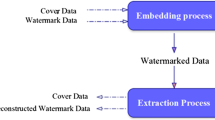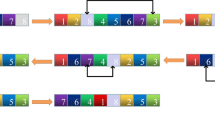Abstract
In this article, a new and improvised image watermarking (IW) technique on colored images is proposed to mitigate robustness and imperceptibility issues found often in the past presented schemes. Most schemes exhibit low robustness due to LSB’s (Least Significant Bit) and MSB’s (Most Significant Bit) based information hiding in the cover image. However, most of these IW schemes have low imperceptibility as the cover image distortion reveals to the attacker due to information hiding in MSB’s. Such IW schemes used to hide the secret message via MSBs and LSBs are susceptible to malicious intruder attacks which results in low robustness, whereas, the attacks on MSB’s have an impact of reduced imperceptibility. Therefore, this paper propounds a digital IW method named as 2D Otsu algorithm, which allows embedding of a grayscale image into a colored host in the wavelet domain. According to this algorithm, the host image is disintegrated into three color bands of blue, red, and green. Each band is divided into small patches leading to the calculation of entropy followed by finding of the threshold that is estimated by taking the average of entropies of all the patches. Wavelet representation of each patch with entropy less than the threshold is given by applying DWT (Discrete Wavelet Transform). Later, by decomposing gray-scale image into binary bits, secret information embedded by quantization technique into optimal wavelet coefficient blocks either encoding wavelet coefficient differences to 0-bits or 1-bits called MultiBit Encoding (MBE). The results obtained show that the imperceptibility and robustness of this proposed model are superior to other proposed watermarking models and this model gives better results than other models at the same payload.




Similar content being viewed by others
References
Abdul W, Ali Z, Ghouzali S, Alfawaz B, Muhammad G, Hossain MS (2017) Biometric security through visual encryption for fog edge computing. IEEE Access 5:5531–5538
Aherrahrou N, Tairi H (2018) A new image watermarking technique based on periodic plus smooth decomposition (PPSD). Soft Comput 22(7):2369–2379
Bhowal DCS, Biswas S, Sarkar PP (2017) A steganographic approach to hide secret data in digital audio based on XOR operands triplet property with high embedding rate and good quality audio. Turk J Electr Eng Comput Sci 25:2136–2148
El-Shafai W, El-Rabaie S, El-Halawany MM, El-Samie FA (2019) Security of 3D-HEVC transmission based on fusion and watermarking techniques. Multimed Tools Appl 78(19):27211–27244
H Jindal, SS Kasana and S Saxena (2016). “A Novel Image Zooming Technique using Wavelet Coefficients”, in Book: Proceedings of International Conference on Recent Cognizance in Wireless Communication and Image Processing, pp. 1-7, Springer, New Delhi, India. [ISBN: 978-81-322-2638-3]
Kaur S, Jindal H (2017) Enhanced image watermarking technique using wavelets and interpolation. International Journal of Image, Graphics and Signal Processing (IJIGSP) 9(7):23–35
Kazemivash B, Moghaddam ME (2018) A predictive model-based image watermarking scheme using regression tree and firefly algorithm. Soft Comput 22(12):4083–4098
Khanduja V, Chakraverty S (2019) A generic watermarking model for object relational databases. Multimed Tools Appl 78(19):28111–28135
Kim C, Shin D, Leng L, Yang CN (2018) Separable reversible data hiding in encrypted halftone image. Displays 55:71–79
Kim C, Shin D, Leng L, Yang CN (2018) Lossless data hiding for absolute moment block truncation coding using histogram modification. J Real-Time Image Proc 14(1):101–114
Kim C, Yang CN, Leng L (2020) High-capacity data hiding for ABTC-EQ based compressed image. Electronics 9(4):644
Lei B, Zhao X, Lei H, Ni D, Chen S, Zhou F, Wang T (2019) Multipurpose watermarking scheme via intelligent method and chaotic map. Multimed Tools Appl 78(19):27085–27107
Leng L, Li M, Kim C, Bi X (2017) Dual-source discrimination power analysis for multi-instance contactless palmprint recognition. Multimed Tools Appl 76(1):333–354
Leng, L, Zhang, J, Xu, J, Khan, MK and Alghathbar, K (2010, November). Dynamic weighted discrimination power analysis in DCT domain for face and palmprint recognition. In 2010 international conference on information and communication technology convergence (ICTC) (pp. 467-471). IEEE
Li J, Lin Q, Yu C, Ren X, Li P (2018) A QDCT-and SVD-based color image watermarking scheme using an optimized encrypted binary computer-generated hologram. Soft Comput 22(1):47–65
Liu, S, Pan, Z, Song, H (2017). “Digital image watermarking method based on DCT and fractal encoding”. IET Image Processing, Volume-11, Issue-10 October 2017, pp: 815–821
Mander K, Jindal H (2017) An improved image compression decompression technique using block truncation and wavelets. International Journal of Image, Graphics and Signal Processing (IJIGSP) 9(8):17–29
Mittal A, Jindal H (2017) Novelty in image reconstruction using DWT and CLAHE. International Journal of Image, Graphics and Signal Processing (IJIGSP) 5(9):28–34
Movaghar RK, Bizaki HK (2017) A new approach for digital image watermarking to predict optimal blocks using artificial neural networks. Turk J Electr Eng Comput Sci 25:644–654
Noor R, Khan A, Sarfaraz A (2019) High performance and energy efficient image watermarking for video using a Mobile device. Wirel Pers Commun 104(4):1535–1551
Noor R, Khan A, Sarfaraz A, Mehmood Z, Cheema A M. (2019). “Highly robust hybrid image watermarking approach using Tchebichef transform with secured PCA and CAT encryption”, soft computing, 1-9
Peng F, Long Q, Lin ZX, Long M (2019) A reversible watermarking for authenticating 2D CAD engineering graphics based on iterative embedding and virtual coordinates. Multimed Tools Appl 78(19):26885–26905
Pilato G, Vassallo G (2015) Tsvd as a statistical estimator in the latent semantic analysis paradigm. IEEE Trans Emerg Top Comput 3:185–192
Heri Prasetyo & Chih-Hsien Hsia (2019). Multimed Tools Appl 78: 29089. https://doi.org/10.1007/s11042-018-6304-y
Shafi I, Noman M, Gohar M, Ahmad A, Khan M, Din S, Ahmad SH, Ahmad J (2018) An adaptive hybrid fuzzy-wavelet approach for image steganography using bit reduction and pixel adjustment. Soft Comput 22(5):1555–1567
Sheng G, Li T, Su Q, Chen B, Tang Y (2017) Detection of content-aware image resizing based on Benford’s law. Soft Comput 21(19):5693–5701
Su Q, Chen B (2018) Robust color image watermarking technique in the spatial domain. Soft Comput 22(1):91–106
Thakkar F, Srivastava VK (2017) A particle swarm optimization and block-SVD-based watermarking for digital images. Turk J Electr Eng Comput Sci 25:3273–3288
Veni M, Meyyappan T (2019) Digital image watermark embedding and extraction using oppositional fruit Fly algorithm. Multimed Tools Appl 78(19):27491–27510
Venugopala P, Sarojadevi H, Chiplunkar NN (2017) An approach to embed image in video as watermark using a mobile device. Sustainable Computing: Informatics and Systems 15:82–87
Wang X, Zhan Y (2019) A zero-watermarking scheme for three-dimensional mesh models based on multi-features. Multimed Tools Appl 78(19):27001–27028
Wang YG, Zhu G, Shi YQ (2018) Transportation spherical watermarking. IEEE Trans Image Process 27(4):2063–2077
Wei, Q, Yin, Z, Wang, Z, Zhang, X (2017). Distortion function based on residual blocks for JPEG steganography. Multimedia tools and applications, 1-14
Zhang L, Wei D (2019) Dual DCT-DWT-SVD digital watermarking algorithm based on particle swarm optimization. Multimed Tools Appl 78(19):28003–28023
Author information
Authors and Affiliations
Corresponding author
Ethics declarations
Conflict of interest
No conflict of interest in this article.
Additional information
Publisher’s note
Springer Nature remains neutral with regard to jurisdictional claims in published maps and institutional affiliations.
Rights and permissions
About this article
Cite this article
Khan, A. 2DOTS-multi-bit-encoding for robust and imperceptible image watermarking. Multimed Tools Appl 80, 2395–2411 (2021). https://doi.org/10.1007/s11042-020-09508-y
Received:
Revised:
Accepted:
Published:
Issue Date:
DOI: https://doi.org/10.1007/s11042-020-09508-y




